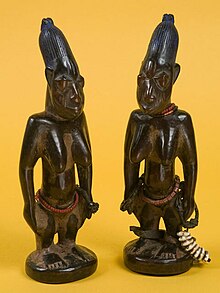
Twins in mythology are in many cultures around the world.[1] In some cultures they are seen as ominous, and in others they are seen as auspicious.[2][3] Twins in mythology are often cast as two halves of the same whole, sharing a bond deeper than that of ordinary siblings, or seen as fierce rivals. They can be seen as representations of a dualistic worldview.[1] They can represent another aspect of the self, a doppelgänger, or a shadow.
Twins are often depicted with special powers. This applies to both mortal and immortal sets of twins, and often is related to power over the weather.[1] Twins in mythology also often share deep bonds. In Greek mythology, Castor and Pollux share a bond so strong that when mortal Castor dies, Pollux gives up half of his immortality to be with his brother. Castor and Pollux are the Dioscuri twin brothers. Their mother is Leda, a being who was seduced by Zeus who had taken the form of a swan. Even though the brothers are twins, they have two different fathers. This phenomenon is a very common interpretation of twin births across different mythological cultures.[2] Castor's father is Tyndareus, the king of Sparta (hence the mortal form).[4] Pollux is the son of Zeus (demigod). This brothers were said to be born from an egg along with either sister Helen and Clytemnestra.[5] This etymologically explains why their constellation, the Dioskouroi or Gemini, is only seen during one half of the year, as the twins split their time between the underworld and Mount Olympus. In an aboriginal tale, the same constellation represents the twin lizards who created the plants and animals and saved women from evil spirits. Another example of this strong bond shared between twins is the Ibeji twins from African mythology. Ibeji twins are viewed as one soul shared between two bodies. If one of the twins dies, the parents then create a doll that portrays the body of the deceased child, so the soul of the deceased can remain intact for the living twin. Without the creation of the doll, the living twin is almost destined for death because it is believed to be missing half of its soul.[6] Twins in mythology are often associated with healing.[1] They are also often gifted with the ability of divination or insight into the future.[1]
Divine twins in twin mythology are identical to either one or both place of a god. The Feri gods are not separated entities but are unified into one center. These divine twins can function alone in one body, either functioning as a male or as male and female as they desire. Divine twins represent a polarity in the world. This polarity may be great or small and at times can be opposition. Twins are often seen to be rivals or adversaries.[7]
- ^ a b c d e Hankoff, Leon D. (1977). "Why The Healing Gods Are Twins". The Yale Journal of Biology and Medicine. 50 (3): 307–319. PMC 2595421. PMID 560764.
- ^ a b Levy, Jerrold E. (August 1964). "The Fate of Navajo Twins". American Anthropologist. 66 (4): 883–887. doi:10.1525/aa.1964.66.4.02a00140. JSTOR 668187 – via JSTOR.
- ^ Malamisti-Puchner, Ariadne (2015). "Twins in Ancient Greece: a synopsis". The Journal of Maternal-Fetal & Neonatal Medicine. 29 (11): 1751–1753. doi:10.3109/14767058.2015.1060958. PMID 26135766. S2CID 44447825 – via Taylor & Francis Online.
- ^ Edmunds, Lowell (2015-10-13), "Dioscuri", Stealing Helen, Princeton University Press, doi:10.23943/princeton/9780691165127.003.0003, ISBN 9780691165127, retrieved 2021-11-25
- ^ Edmunds, Lowell (2015-10-13), "Dioscuri", Stealing Helen, Princeton University Press, doi:10.23943/princeton/9780691165127.003.0003, ISBN 9780691165127, retrieved 2021-11-25
- ^ Flatley, Robert. "Kanopy".
{{cite journal}}: Cite journal requires|journal=(help) - ^ McIntosh, Mark A. (2021-03-04), "The Divine Ideas Tradition in Christianity", The Divine Ideas Tradition in Christian Mystical Theology, Oxford University Press, pp. 12–40, doi:10.1093/oso/9780199580811.003.0002, ISBN 978-0-19-958081-1, retrieved 2021-11-25